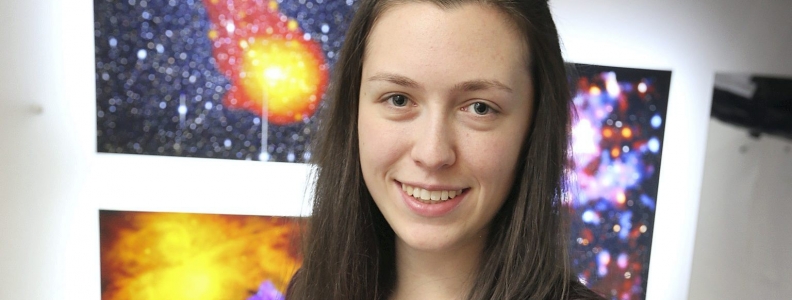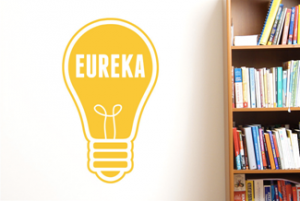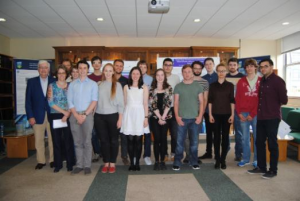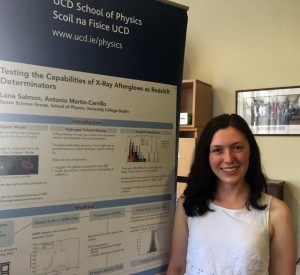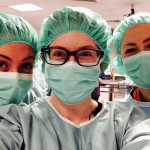Science can be very unpredictable! 5 weeks into my 8 week internship as part of the UCD School of Physics Summer Internship Program, I found myself a little stuck. My project focused on Gamma-Ray Bursts (GRBs) – the most powerful electromagnetic explosions in the Universe that occur when a star collapses. Using data from the Swift and XMM Newton satellites, I was using X-Ray data to try and understand these bursts.
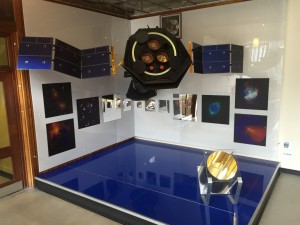
The second floor of the UCD Physics Building has a scale model of XMM Newton, a European Space Agency satellite. I pass by this on my way to class each morning!
Using a programme called XSPEC, I was using the X-Ray data to get two things:
- Redshift – a measure of the stretching of light as objects move away from us, making the light look ‘redder’.
- Hydrogen Column Density – a measure of the amount of gas this light passes through on its way to us.
My results were looking a bit funny. In most of the 32 bursts I tried, the redshift and column densities calculated by XSPEC were higher than the real values.
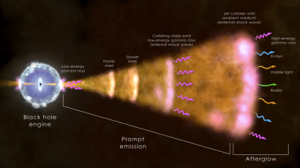
A schematic of a Gamma-Ray Burst : A star explodes and interacts with surrounding matter – we analyse the light from this
I can’t deny that I felt lost at this point, but a chat over lunch to the other 15 interns – from UCD, Trinity, DCU and even France – made me feel a little less alone. A quick call to my supervisor – Dr. Antonio Martin Carrillo – gave me some new ideas. Having been taught by him before, I knew the internship with him was going to be challenging but also fun. His enthusiasm for astrophysics is infectious!
Antonio directed me to some papers to explain this. They claimed that dust and gas around the collapsed star complicates the results, or maybe the GRBs weren’t bright enough.
But Antonio also suggested that fixing the Hydrogen Column Density to a fixed value could help. I fixed this and obtained new redshifts. Low and behold, these were much closer to the real redshifts!
One thing I’ve learned from this internship is that in science you can never be too sure. I double checked my errors and plotted contour plots to see the distribution of my errors.
I then tried to see how this method works with brighter GRBs. I found that the redshift changes by only a small amount when the GRB is brighter. So the brightness of the GRB can’t be the reason for the wrong redshift calculated earlier! There must be a physical reason the redshift was wrong.
Maybe it’s the gas around the star, or the gas in our galaxy. Antonio came up with another idea on our last day – maybe the column density changes with time, therefore we can’t fix it to one value. That’s one of the exciting things about research, there are so many possibilities!
With one week left to go, I had to start preparing for the poster competition. I found it hard to condense all of these results onto one poster, but I did it! On our last day, myself and the 16 other interns gathered in the physics common room to be quizzed on our 8 weeks. 3 judges walked around and spoke to all of us, and it was very fulfilling to be able to discuss my poster with other astrophysicists to get their insights and advice.
The judges remarked that the standard of the posters was very high – that they would be acceptable at an international conference. They found it very difficult to pick a winner and were in awe that we were only undergraduates. It was nice to hear such lovely comments after all our hard work.
To my surprise, I won the poster competition! I think overall this internship showed me that a career in research can be exciting and unpredictable – at times frustrating – and a collaborative effort. Antonio was more than helpful throughout the whole 8 weeks – I have to thank him for passing on his enthusiasm and giving me the chance to try a career in research.
I look forward to exhibiting my poster at the Irish National Astronomy Meeting in UCD in September and getting to discuss my results with even more astrophysicists from all over Ireland.
I would like to thank the UCD School of Physics for their support of this program. I had an amazing 8 weeks among fantastic students and researchers. Since I now have to begin to think about my future plans, this internship has pushed me towards applying for a Research Masters. I look forward to this journey ahead!
This blog is written by Physics with Astronomy & Space Science student Lána, who took part in the UCD Physics Summer Internship Program. The program is designed and aimed at undergraduate students who are interested in developing their independent Physics research abilities, while being directed and supervised by UCD Physics academics. Further details of the programme are available on the UCD School of Physics website.


